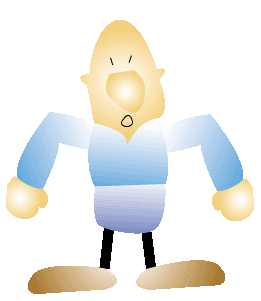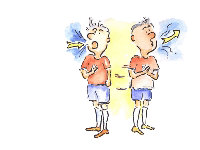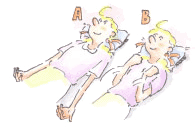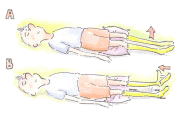Origin:
Progressive relaxation was developed by Edmund Jacobson, a physician in 1930's. He taught his patients a series of exercises in order to reduce their muscle tension syndrome. Firstly, it required them to contract a muscle group, then relax it, and then move from one muscle group to another. The purpose was to teach them to recognize what their muscle tension and relaxation felt like, and to familiar with progressive relaxation training, so that they could practise progressive relaxation when they felt tense.
Benefits of Progressive Relaxation Training:
| (1) | Physiological aspects: It can relax smooth muscles, gastrointestinal and cardiovascular systems. It can reduce tension and headaches. |
| (2) | Psychological aspects: It can minimize depression and anxiety, boost self-esteem, make sleep easier, increase job and competitive performances. |
Prerequisites:
(1) |
|
(2) |
|
(3) |
|
The tape shows you how to relax four major muscle groups in your body. First, your hands and arms; second, your head and neck, and shoulders; third, your chest and stomach, and lower back; and fourth, your legs and feet. Sit in a comfortable chair or lying down. Put your arms at your sides and legs slightly apart. Move around a little until you are comfortable. Follow these simple instructions carefully.

(Hands
and Arms)Close
your eyes, take a deep breath, hold it in, and release it slowly through
your mouth.  First,
you will concentrate on your hands, forearms, and biceps. Clench your
right fist, tighter and tighter, studying the tension as you clench
it. Keep it clenched and notice the tension in your fist, hand, and
forearm, now let your fist relax, feel the looseness in your right
hand, notice
the contrast with the tension. Your hand may feel warm, heavy, tingling,
or all three. Clench your right hand again into a fist. Really dwell
on the strain. Now, let your fist relax; notice how much looser and
heavier it feels. Compare it with the feeling before. Does
it tingle or feel warm. Continue to notice the feeling of relaxation.
First,
you will concentrate on your hands, forearms, and biceps. Clench your
right fist, tighter and tighter, studying the tension as you clench
it. Keep it clenched and notice the tension in your fist, hand, and
forearm, now let your fist relax, feel the looseness in your right
hand, notice
the contrast with the tension. Your hand may feel warm, heavy, tingling,
or all three. Clench your right hand again into a fist. Really dwell
on the strain. Now, let your fist relax; notice how much looser and
heavier it feels. Compare it with the feeling before. Does
it tingle or feel warm. Continue to notice the feeling of relaxation.

Now switch to your left fist. Clench your left fist tighter and tighter,
studying the tension as you clench it. Keep it clenched tight and
notice the tension throughout your hand and
forearm. Now let your left fist relax, feel
your looseness
in your left hand. Notice the contrast with the previous tension.
There
may be the same warm, heavy, tingling feeling as in the other hand
or it might be different. Clench your left hand again into a really
tight fist. Concentrate with all your attention on the strain. Let
your fist relax. Notice how much looser and heavier it feels. Compare
it with the feeling the first time you clenched it. Describe to yourself
how it feels. Now clench both fists. Relax, notice the feeling of
relaxation. Now lift both arms at once, make two tight fists, bend
your elbows and flex yourbiceps, study the tension in both arms from
your hands up through your forearms to your biceps. Let your arms
fall back and relax them totally.
Notice
the relaxation. Compare
it to the strain you felt before. Once again, lift and flex both arms
as tightly as you can, hold it, and relax slowly. Lie or sit still
a moment and feel the relaxation deepen in both your arms. Just let
your arms go and sink into the bed or chair. Take a deep breathe and
exhale slowly through your mouth.
and relax them totally.
Notice
the relaxation. Compare
it to the strain you felt before. Once again, lift and flex both arms
as tightly as you can, hold it, and relax slowly. Lie or sit still
a moment and feel the relaxation deepen in both your arms. Just let
your arms go and sink into the bed or chair. Take a deep breathe and
exhale slowly through your mouth.
 (Head
and Neck)Now
we'll give some attention to your head, neck, and shoulders. From the
point of view of stress, these muscle groups contain the most important
muscles in your body. Turning the focus to your head, raise your eye-brows
as high as you can and hold it. Now relax and smooth it out. Let yourself
imagine your entire forehead and scalp becoming smooth and at rest.
Raise your eye brows again as high as you can. Let it all go. Allow
your forehead to become as smooth as silk. Close your eyes now and squint
them together very tightly, hold them together and now relax your eyes.
Let them remain closed -- gently and comfortably. Once more, close your
eyes very tightly, hold them shut tight, and relax. Enjoy your smooth,
relaxed face.
(Head
and Neck)Now
we'll give some attention to your head, neck, and shoulders. From the
point of view of stress, these muscle groups contain the most important
muscles in your body. Turning the focus to your head, raise your eye-brows
as high as you can and hold it. Now relax and smooth it out. Let yourself
imagine your entire forehead and scalp becoming smooth and at rest.
Raise your eye brows again as high as you can. Let it all go. Allow
your forehead to become as smooth as silk. Close your eyes now and squint
them together very tightly, hold them together and now relax your eyes.
Let them remain closed -- gently and comfortably. Once more, close your
eyes very tightly, hold them shut tight, and relax. Enjoy your smooth,
relaxed face.


Now shrug your shoulders. Keep the tension as much as you hunch your head down between your shoulders. Now relax your shoulders and allow them to drop back. Feel the relaxation spreading through your neck, throat, and shoulders. Feel the relaxation spreading through your neck, throat, and shoulders. Feel relaxation deeper and deeper. Once again, hunch your shoulders. Now relax.
(Chest and Stomach)Give your body a chance to relax as you move your attention down to your chest. Feel the comfort and heaviness. Now, breathe in and fill your lungs completely. Push out your belly with your breath, hold your breathe. Notice the tension in your chest. Now exhale, letting the air hiss out of your mouth. Continue breathing normally; continue relaxing, letting your breathe come freely and gently for the next 30 seconds. Now take another deep breathe and hold it. Notice the tension in your chest. Now exhale loudly through your mouth, blowing the air out in a smooth stream. Resume normal easy breathing. For the next 30 seconds, just breathe slowly, feeling a sense of calm and peace spreading throughout your body. Fine. Next, tighten your stomach and hold it. Relax, notice the difference between your rigid stomach muscles and relaxed feeling. Now put your hand on your stomach; breathe deeply into your stomach, pushing your hand up; hold, then relax. Feel how the breathing deepens the feeling of relaxation. Now, without straining, arch your back. Concentrate on the tension in the lower back. Now relax; relax, deeper and deeper. Once more, arch your back and tense the muscles of your lower back; hold it and relax. Be still a moment and let the relaxation sink into your body.
(Legs
and Feet)Finally
you can work on relaxing the big powerful muscles of your legs. Tighten
your buttocks and tighs by pressing your heels into the floor as hard
as you can. Focus on the tension and now relax. Notice the profound
difference. Again, press your heels downward to put tension on your
buttocks and thighs; hold it; hold it; and relax. Now curl your toes
slowly downward, making your calves tense.  Don't
strain too hard or your feet may cramp. Hold it and relax, letting the
looseness flood your calf muscles. Curl your toes down and under again,
tensing the calf muscles; hold it and relax. Notice how relaxed your
calves feel. Good. Bend your toes towards your face, putting strain
on your shins. Hold your toes up and notice the tension. Let go and
allow your shins to relax. Again curl your toes up and tense your shins
and release. Notice the difference between the tension and relaxation.
Now lie or sit still and feel a heaviness throughout your body; let
the relaxation deepen, relax your feet, ankles, calves, shins, knees,
thighs, and buttocks. Let the relaxation spread to your stomach, lower
back, and chest. Let go more and more; experience the relaxation deepening
in your shoulders, arms, and hands, deeper and deeper. Notice the feeling
of looseness and relaxation in your, neck, jaws and all your facial
muscles. Take a deep breath, hold it a moment and let it out slowly.
When you open your eyes in awhile, you will feel alert and refreshed.
As you go back your daily routine, you will recall the stage of deep
relaxation and use the memory to relax the muscles that will otherwise
tense up during stress. Now continue breathing slowly. Visualize the
details in the room around you. When you feeling ready, open your eyes
slowly. Orient yourself to your surroundings. Get up slowly and stretch.
Notice how relaxed, refreshed, and alert you feel. This feeling can
be yours anytime you want to achieve it.
Don't
strain too hard or your feet may cramp. Hold it and relax, letting the
looseness flood your calf muscles. Curl your toes down and under again,
tensing the calf muscles; hold it and relax. Notice how relaxed your
calves feel. Good. Bend your toes towards your face, putting strain
on your shins. Hold your toes up and notice the tension. Let go and
allow your shins to relax. Again curl your toes up and tense your shins
and release. Notice the difference between the tension and relaxation.
Now lie or sit still and feel a heaviness throughout your body; let
the relaxation deepen, relax your feet, ankles, calves, shins, knees,
thighs, and buttocks. Let the relaxation spread to your stomach, lower
back, and chest. Let go more and more; experience the relaxation deepening
in your shoulders, arms, and hands, deeper and deeper. Notice the feeling
of looseness and relaxation in your, neck, jaws and all your facial
muscles. Take a deep breath, hold it a moment and let it out slowly.
When you open your eyes in awhile, you will feel alert and refreshed.
As you go back your daily routine, you will recall the stage of deep
relaxation and use the memory to relax the muscles that will otherwise
tense up during stress. Now continue breathing slowly. Visualize the
details in the room around you. When you feeling ready, open your eyes
slowly. Orient yourself to your surroundings. Get up slowly and stretch.
Notice how relaxed, refreshed, and alert you feel. This feeling can
be yours anytime you want to achieve it.
Note. From Relaxation and Stress Reduction Cassette Tapes by M. McKay & P. Fanning, 1983, Oakland, CA: New Harbinger.
